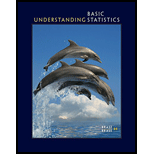
Concept explainers
Expand Your knowledge: Alternate Method for Confidence Intervals When a is unknown and the sample is of size
Method 1: use the Student’s t distribution with d.f. = n - 1.
This is the method used in the text. It is widely employed in statistical studies Also, most statistical software packages use this method.
Mrthod 2: When
This method is based on the fact that for large samples, s is a fairly good approximation for
Consider a random sample of size n = 31, with sample mean x = 45.2 and sample standard deviation s = 5.3.
(a) Compute 90%, 95%, and 99% confidence intervals for µ using Method 1 with a Student’s t distribution. Round endpoints to two digits after the decimal.
(b) Compute 90%, 95% and 99% confidence intervals for µ using Method 2 with the standard normal distribute. Use s as an estimate for
(c) Compare intervals for the two methods. Would you say that confidence intervals using a Student’s t distribute are more conservative in the sense that they tend to be longer than intervals based on the standard normal distribute ?
(d) Repeal parts (a) through (c) for a sample of size n = 81. With increased
(a)
To find: The90%, 95%, and 99% confidence intervals for
Answer to Problem 23P
Solution:
The 90%, 95% and 99% confidence interval for
Explanation of Solution
Calculation:
Let
We have to find 90% confidence interval,
90% confidence interval is
The 90% confidence interval for
We have to find 95% confidence interval,
95% confidence interval is
The 95% confidence interval for
We have to find 99% confidence interval,
99% confidence interval is
The 99% confidence interval for
(b)
To find: The 90%, 95%, and 99% confidence intervals for
Answer to Problem 23P
Solution:
The 90%, 95% and 99% confidence interval for
Explanation of Solution
Calculation:
Let
We have to find 90% confidence interval,
90% confidence interval is
The 90% confidence interval for
We have to find 95% confidence interval,
95% confidence interval is
The 95% confidence interval for
We have to find 99% confidence interval,
99% confidence interval is
The 99% confidence interval for
(c)
Whether the confidenceintervals using a Student’s t distribution are more conservative.
Answer to Problem 23P
Solution:
Yes, the confidenceintervals using a Student’s t distribution are more conservative.
Explanation of Solution
Yes, the confidenceintervals using a Student’s t distribution is slightly longer than the intervals based on the standard normal distribution. Hence, the respective confidenceintervals using a Student’s t distribution are more conservative.
(d)
The 90%, 95%, and 99% confidence intervals for
Answer to Problem 23P
Solution:
The 90%, 95% and 99% confidence interval for
Explanation of Solution
Let
Using Method 1 with a Student’s t distribution:
We have to find 90% confidence interval,
90% confidence interval is
The 90% confidence interval for
We have to find 95% confidence interval,
95% confidence interval is
The 95% confidence interval for
We have to find 99% confidence interval,
99% confidence interval is
The 99% confidence interval for
Using Method 2 with the standard normal distribution:
We have to find 90% confidence interval,
90% confidence interval is
The 90% confidence interval for
We have to find 95% confidence interval,
95% confidence interval is
The 95% confidence interval for
We have to find 99% confidence interval,
99% confidence interval is
The 99% confidence interval for
The confidenceintervals using a Student’s t distribution is slightly longer than the intervals based on the standard normal distribution. As the sample size increases, the difference between the two methods is less pronounced. That means with increased sample size, the two methods give respective confidence intervals that are more similar.
Want to see more full solutions like this?
Chapter 8 Solutions
Understanding Basic Statistics
- A marketing agency wants to determine whether different advertising platforms generate significantly different levels of customer engagement. The agency measures the average number of daily clicks on ads for three platforms: Social Media, Search Engines, and Email Campaigns. The agency collects data on daily clicks for each platform over a 10-day period and wants to test whether there is a statistically significant difference in the mean number of daily clicks among these platforms. Conduct ANOVA test. You can provide your answer by inserting a text box and the answer must include: also please provide a step by on getting the answers in excel Null hypothesis, Alternative hypothesis, Show answer (output table/summary table), and Conclusion based on the P value.arrow_forwardA company found that the daily sales revenue of its flagship product follows a normal distribution with a mean of $4500 and a standard deviation of $450. The company defines a "high-sales day" that is, any day with sales exceeding $4800. please provide a step by step on how to get the answers Q: What percentage of days can the company expect to have "high-sales days" or sales greater than $4800? Q: What is the sales revenue threshold for the bottom 10% of days? (please note that 10% refers to the probability/area under bell curve towards the lower tail of bell curve) Provide answers in the yellow cellsarrow_forwardBusiness Discussarrow_forward
- The following data represent total ventilation measured in liters of air per minute per square meter of body area for two independent (and randomly chosen) samples. Analyze these data using the appropriate non-parametric hypothesis testarrow_forwardeach column represents before & after measurements on the same individual. Analyze with the appropriate non-parametric hypothesis test for a paired design.arrow_forwardShould you be confident in applying your regression equation to estimate the heart rate of a python at 35°C? Why or why not?arrow_forward
 Glencoe Algebra 1, Student Edition, 9780079039897...AlgebraISBN:9780079039897Author:CarterPublisher:McGraw Hill
Glencoe Algebra 1, Student Edition, 9780079039897...AlgebraISBN:9780079039897Author:CarterPublisher:McGraw Hill Big Ideas Math A Bridge To Success Algebra 1: Stu...AlgebraISBN:9781680331141Author:HOUGHTON MIFFLIN HARCOURTPublisher:Houghton Mifflin Harcourt
Big Ideas Math A Bridge To Success Algebra 1: Stu...AlgebraISBN:9781680331141Author:HOUGHTON MIFFLIN HARCOURTPublisher:Houghton Mifflin Harcourt

